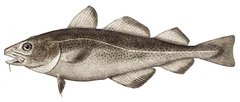Atlantic cod
|
|
| Atlantic cod Conservation status: Vulnerable | ||||||||||||||
|---|---|---|---|---|---|---|---|---|---|---|---|---|---|---|
 Atlantic cod | ||||||||||||||
| Scientific classification | ||||||||||||||
| ||||||||||||||
| Binomial name | ||||||||||||||
| Gadus morhua Linnaeus, 1758 |
The Atlantic cod (Gadus morhua) is a well-known foodfish belonging to the family Gadidae which in ancient greek means a whales uterus. It grows to two metres (6 1/2 feet) in length. Colouring is brown to green on the dorsal side, shading to silver ventrally. Its habitat ranges from the shoreline down to the continental shelf.
In the western Atlantic Ocean cod has a distribution north of Cape Hatteras, North Carolina, and round both coasts of Greenland; in the eastern Atlantic it is found from the Bay of Biscay north to the Arctic Ocean, including the North Sea, areas around Iceland and the Barents Sea, which is the most important feeding area.
Distribution
Northeast Atlantic cod
The northeast Arctic or Arcto-Norwegian stock is at present the world's largest population of Atlantic cod. This stock is sometimes referred to as skrei, a Norwegian name meaning something like "the wanderer", distinguishing it from non-migrating coastal cod. This stock spawns in March and April on the Norwegian coast, traditionally around the Lofoten archipelago, but also both further north and south. Newly hatched larvae drift northwards with the coastal current while feeding on larval copepods. By summer the young cod reach the Barents Sea where they stay for the rest of their life, until their spawning migration. As the cod grow, they feed on krill and other small crustaceans and fish. Adult cod primarily feed on fish such as capelin and herring. The northeast Arctic cod also shows cannibalistic behaviour, especially when there is little capelin available.
The North Sea cod stock is primarily fished by European Union member states. In 1999 the catch was divided amung Denmark (31%), Scotland (25%) the United Kingdom, comprised of England, Wales and Northern Ireland, (12%), the Netherlands (10%), Belgium, Germany and Norway (17%). In the 1970s, the annual catch was 200,000 - 300,000 tons, however catch quotas were repeatedly reduced in the 1980s and 1990s. Despite this, the spawning biomass is estimated to have been well below the precautionary level since 1984, and is presently at an historically low level. In 2003, ICES stated that there is a high risk of stock collapse if current exploitation levels continue, and recommended a total moratorium on Atlantic cod fishing in the North Sea during 2004. However Agriculture and Fisheries ministers from the Council of the European Union set the catch limit at 27,300 tons.
Declining populations
Cod_catch_1950_2002.png
The spawning stock of cod (those over 7 years of age) was more than a million tons following World War II, but declined to a historic mimimum of 118,000 tons in 1987. The catch reached an historic maximum of 1,343,000 tons in 1956, and bottomed out at 212,000 tons in 1990. Since 2000, the spawning stock has increased quite fast, helped by low fishing pressure. However, there are worries about a decreased age at first spawning (often an early sign of stock collapse), combined with the level of discards and unreported catches. The total catch in 2003 was 521,949 tons, the major fishers being Norway (191,976 tons) and Russia (182,160 tons).
Northwest Atlantic cod
The northwest Atlantic cod has been regarded as heavily overfished throughout its range, resulting in a crash in the fishery in the United States and Canada during the early 1990s. The fishery has yet to recover, and may not recover at all because of a possibly stable change in the food chain. Atlantic cod was a top-tier predator, along with haddock, flounder and hake, feeding upon smaller prey such as herring, capelin, shrimp and snow crab. With the large predatory fish removed, their pray has had a population explosion and have become the top predators. Young Atlantic Cod have become the prey in the northwest Atlantic, making recovery extremely slow as they do not spawn until about 7 years of age. The northwest Atlantic populations spawn in the winter and spring at Georges Bank in the Cape Cod region.
Population tracking
Cod populations or stocks can differ significantly both in appearance and biology. For instance, the cod stocks of the Baltic Sea are adapted to low-salinity water. Organizations such as the Northwest Atlantic Fishery Organization (NAFO) and ICES divide the cod into management units or stocks; however these units are not always biologically distuigishable stocks. Some major stocks/management units on the Canadian/US shelf are (see map (http://www.dfo-mpo.gc.ca/kids-enfants/map-carte/map_e.htm) of NAFO areas) are the Southern Labrador-Eastern Newfoundland stock (NAFO divisions 2J3KL), the Northern Gulf of St. Lawrence stock (NAFO divisions 3Pn4RS), the Northern Scotian Shelf stock (NAFO divisions 4VsW), which all lie in Canadian waters, and the Georges Bank and Gulf of Maine stocks in USA waters. In the European Atlantic, there are separate stocks on the shelves of Iceland, the Faeroes, and Western Scotland, in the North Sea, Irish Sea and Celtic Sea, and two stocks in the Baltic Sea (the western and the eastern stock).
See also
External links
- FishBase (http://www.fishbase.org/Summary/SpeciesSummary.cfm?genusname=Gadus&speciesname=morhua)
- Codtrace (http://www.ucd.ie/codtrace/codbio.htm)
- The Centre for Environment Fisheries and Aquaculture Science (http://www.cefas.co.uk/fishinfo/gadus_morhua.htm)
- Skrei - the miraculous cod (http://www.slowfood.com/img_sito/riviste/slow/EN/23/skrei.html)
- The history of the northen cod fishery in Canada (http://www.cdli.ca/cod/home1.htm)
- ICES recommendation for the North Sea Cod stock (2003) (http://www.ices.dk/committe/acfm/comwork/report/2003/oct/cod-347d.pdf)
- ICES recommendation for the North East Arctic Cod stock (2004) (http://www.ices.dk/committe/acfm/comwork/report/2004/may/cod-arct.pdf)
- Reports on the status of Canadian fishing stocks, including cod (http://www.dfo-mpo.gc.ca/csas/Csas/English/Status/Status_Reports2004_e.htm)da:Torsk
